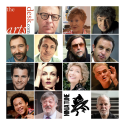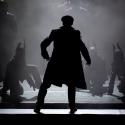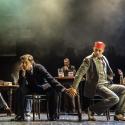The ballet world will soon run out of titles signifying a renaissance. After ENB’s recent Re:evolution comes London City Ballet’s Rebirth, following its debut programme last year called Resurgence. In LCB’s case, the term is quite literal.
The company resurfaced, after a nearly 30-year hiatus, under the directorship of Christopher Marney, whose formula for the new-look group is a winning one. Bring together fine dancers from all corners of the globe and send them out to perform in smaller venues, where they can explore rich, sometimes under-explored seams in the modern ballet repertoire. Add guest turns from the peerless Alina Cojocaru, and you have the makings of a pocket company with big ambitions.
LCB have now arrived for the first time at Covent Garden, in the Linbury space, where they are fielding 12 dancers, all exceptional, 10 of them on duty at each performance. Cojocaru was not with them on opening night, but it’s still a treat for ballet-lovers, offering a UK premiere (Jerome Robbins’s Quiet City from 1986) and a world premiere (Tasha Chu’s Soon), alongside deserved returns for Ashley Page’s Larina Waltz (created for the Royal Ballet in 1993) and Alexei Ratmansky’s Pictures at an Exhibition, made on New York City Ballet in 2014).
Wisely, the bill opens with the exuberant charmer Page created for four Royal Ballet couples, here expanded to five. As Tchaikovsky’s stirring waltz from Eugene Onegin (the opera) sounds out, the absence of a live orchestra is balanced by the show-off classicism of the steps, all inventive lifts and explosive grands jetés, building to a mini-Symphony in C ensemble finale of presto precision.
Robbins’s Quiet City is a total change of mood, a measured piece to Aaron Copland’s music of that title, showcasing a mournful solo trumpet that evokes the urban loneliness of New York City. A crowd (extras recruited from the Royal Ballet School), silhouetted against a sky the colour of a fading bruise, is suddenly joined by three serene men in white, who move in a stately way. Two are attendants of some kind, supporting the third (Alejandro Virelles) when he falls to the ground, then helping him to rise again. The piece is a memorial to Joseph Duell, a New York City Ballet dancer who committed suicide in 1986. That detail is supplied by a programme note, but you don’t need it to grasp that the piece is about a man whose spirit is flagging and desperate for sustenance.
Tasha Chu’s new piece, Soon, is also about souls in extremis, here a couple (Sahel Flora Pascual and Simeon Sorange-Felicité) in a darkened space who seem to be braced for news from a sad man in a white coat, who then quietly exits. They are joined by four dancers, three men, one woman, who circle and support them, in moves — to Gavin Briars’ Jesus’ Blood never failed me yet, all electronic whooshes and bleeps until the title refrain Briars recorded an old man singing starts up — often flailing and dramatic, at times reminiscent of Wim Wandekeybus’s floorbound tumbles and rolls. The couple’s desire to be with each other grows more emphatic, she launching herself at him like a final-act Manon; but they slowly separate, and she is left, poignantly, to follow the light to its source. It's a more opaque piece than the Robbins, which you do need the programme note to guide you through.
Throughout the first half, the dancers impress with their assured control, energy and intelligent acting. The icing on that particular cake is their performance of Ratmansky’s Pictures at an Exhibition, which is given the whole of the second half. This is a piece that sounds like a wacky idea, an attempt to transform Mussorgsky’s impressionistic piano suite from 1874 into a coherent ballet. But it works, and the more you see it, the more you want to see it again.
At the piano is the redoubtable Reina Okada, who tackles the exacting score’s cascading scales and thundering chords with verve. As do the dancers, who assume different personas for each “picture”, driven by unseen forces, anxieties and passions and taking the stop-start nature of the piece and its jittery time signatures in their stride. My only quibble is the costume design, which kits them out in odd gauzy tabards and trews, each using a different colour-block design. Easy to dance in, perhaps, but oddly flimsy. But the look of the piece is enhanced by the backdrop of projected abstract shapes that begin as a block which then fragments as the shapes regroup with each section.
Ratmansky’s witty recycling of styles ranging from Russian folk dance to Balanchine’s teasing neo-classicism is a feast to go home with. Long may it stay a regular party-piece that sends audiences home happy.
Rebirth at the Linbury Theatre until November 22













Add comment